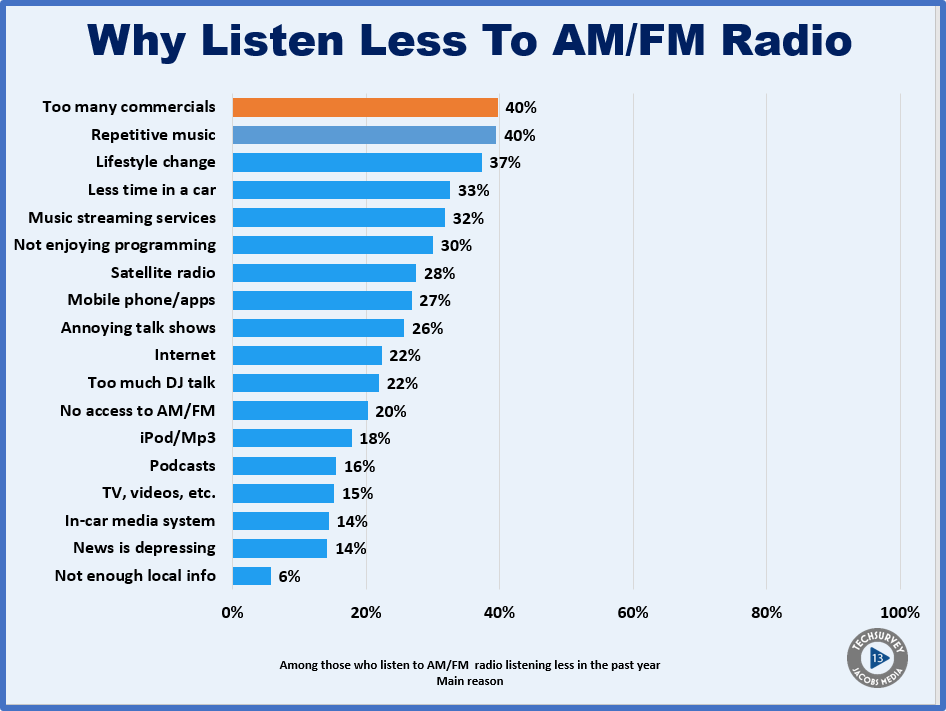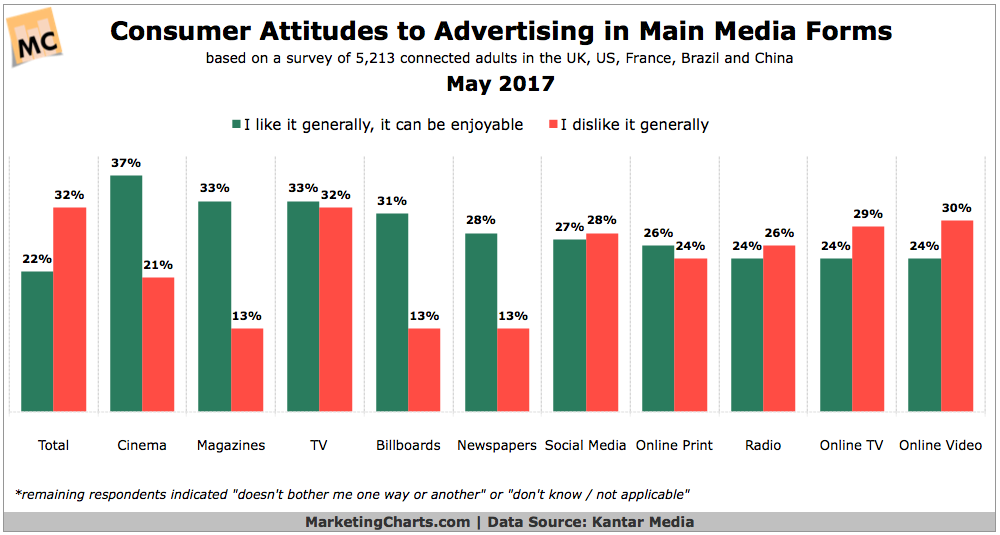
As I make Techsurvey13 presentations around the country at conferences and on webinars, I’m starting to hear feedback about the various data points that truly resonate with radio pros. From the growth spurt of “smart speakers” (like Amazon’s “Alexa”) to the podcast categories that are most popular, there’s some amazing findings generated from our 51,670 respondents.
Radio acquits itself well in Techsurvey13. In fact, only one in ten says they’re listening to less broadcast radio in the past year – same as in TS12. But what’s the cause of that tune-out? Of course, streaming services like Pandora and Spotify, mobile apps, and satellite radio are all somewhat erosive. But the top two radio complaints among those spending less time with the medium turn out to be self-inflicted wounds:
- Too many commercials
- Repetitive music
Both are mentioned by four in ten of those who have decreased their time spent listening to radio in the past year:
 So how does this manifest itself in the larger ecosystem of media and digital advertising? What role does the quantity as well as the quality of radio advertising play in the bigger scheme of things when media buyers make their financial decisions to choose one medium or platform over another?
So how does this manifest itself in the larger ecosystem of media and digital advertising? What role does the quantity as well as the quality of radio advertising play in the bigger scheme of things when media buyers make their financial decisions to choose one medium or platform over another?
A recent Kantar Media study asked 5,200+ connected adults from Brazil, China, France, the UK, and the US to rate advertising from a variety of sources from digital to traditional.
While online TV and video are often criticized, ads in movie theaters, magazines, and newspapers have strong consumer ratings. But the bad news is that radio ads leave much to be desired. In fact, consumers are more likely to negatively rate commercials on the radio compared to those who generally like them. And these responses help crystallize the responses we saw in TS13:
 So, it’s hard not to conclude that when it comes to its commercial monetization efforts, radio has its challenges. This isn’t anything new, but as commercial stopsets have become more cluttered with even poorer quality ads in recent years, these conditions take their toll on both those listening, as well as those advertising on the medium.
So, it’s hard not to conclude that when it comes to its commercial monetization efforts, radio has its challenges. This isn’t anything new, but as commercial stopsets have become more cluttered with even poorer quality ads in recent years, these conditions take their toll on both those listening, as well as those advertising on the medium.
Commercials are part of the overall radio experience. As most consumers know, they are the price one pays in exchange for radio being “free.” But when they become a reason for both “meter migration” in the ratings, and advertiser malaise, it’s a problem.
A quantity problem and a quality problem.
Perception is reality.
See the Techsurvey13 Results
Techsurvey is the radio industry’s largest online survey. See the results for yourself.
- There’s No Place Like (At) Home - March 19, 2025
- Radio’s Personality Dilemma - March 18, 2025
- VOA RIFed - March 17, 2025




“Making Every Minute Count…Making it Groovy” – Spanky & Our Gang, 1967. Poor sounding spots and bad music curation. No kidding. Excellent study, Thank you, Fred! Clark, Boston. http://www.broadcatideas.com
Appreciate it, Clark.
All the more reason to improve quality for both listeners and advertisers.
A clarion call, don’t you think? Thanks, Joel.
Well said, Fred. Radio offers an amazing canvas for effective ads. More time training in the art of content integration verses separation would serve the industry well. Thanks for the reminder!
Thanks for the comment and for reading our blog, Leon.
ONLY 10% are listening to less radio – the same as last year. That’s 20% in two years which is a lot. Does PPM actually verifies this, or is it just listener perception. Remember all of those focus groups were people said they were offended by and never listened to Howard, then followed with accurate summaries of his last 5 shows.
There is another 20% number that’s troubling – the less access to AM/FM. That’s significant and self fulfilling – radios are cheap and if any of those 20% missed AM/FM they would buy $20 a radio.
As for commercials, I doubt whether they’re significantly different or worse than they were in radio’s heyday. They always sucked – and as far back as college radio we used to laugh at lines like “for all your ____ needs”. Yet I’ll bet there’s more than one radio ad with that line running in every one of the top 300 markets right now. More options may have made radio listeners more picky about the things that always bothered them.
Most radio ads are produced by someone else – so how much leverage does the industry have to fix the problem?
So, I need to make an interpretive comment here. The 10% listening less data point – same as last year – is NOT additive. It’s simply that each year, one in ten people say they’re listening to less radio this year. And 17% say they’re listening more (and that’s NOT additive to last year’s 18% listening more). It is merely a reflection of the more/less/same activity in any given year.
That said, I would subjectively submit the commercial environment is considerably worse that it was years ago. Stations run more inventory than 20 or 30 years ago. And with national business drying up for so many stations, the chance to create and manage better local spots is something that companies/clusters/stations could undertake if this was a priority.
Thanks, Bob.
Point taken on the listen/listen less – that’s actually a nicely encouraging sign. As for the current/vs. 30 year ago environment – how does the unit count compare to 30 years ago? How much worse is it? As for the spot quality – I think most local advertising is produced somewhere besides the station, so that will be harder to address
Good question on spotloads today vs. the ’90s (or the ’80s). My suspicion is that unit counts and minutes/hour are higher today, but I honestly don’t know. And the idea of local commercials being produced in-house by producers who are talented, well-paid, and supported would contribute to a better product.
Kiss 108 in the 1980’s and early ’90’s outside of morning drive played 7 units an hour, usually two breaks of 3 & 4.. enabling “12 in a Row”. Today the number is likely closer to 20, with 10 minute long stop sets considered normal. Compounding the issue: 7 units an hour was when listeners had *no alternative* to radio. Spotloads dramatically increased at worst possible time: just as iPods & high speed internet streaming emerged. Today a Spotify stopset usually runs under 2 minutes, compared to radio’s obscene 10 minute long commercial binges. In an ideal world stations would fetch 3x the rates they’re now getting so they could reduce inventory.
And comparisons between radio and pureplays are obvious to consumers. Thanks for the comment, Jeff.
This topic lit my fuse this morning. I don’t usually bring up the past as better and shinier than the present but I will on this topic. When I was on staff at Detroit’s WABX the air staff participated in writing and acting in mostly local commercials. It was not unusual to hear the lady from the traffic department playing the role of a hair doctor or a chicken who wanted to be a sandwich. We believed national commercials were audience killers and our comedic little 30 second local spots should be, drum roll, entertaining. A couple of years ago I was sent a CD full of those little drama’s. Some are truly radio art. The cure for the commercial blues is your imagination. Thanks for letting me vent.
Dan, in this case, you’re totally justified. “Back in the day,” radio took much greater care to craft, write, and produce commercials that were congruent with the station brand. Part of that was done to protect the audience from hearing commercials that were a huge tune-out. And the other side of it was going to lengths to ensure an advertiser’s campaign had a achance of working. Vent away.
Great info! Any insight on some things that are working? I know you guys consult some stations that are trying different things. 107.7 The end in Seattle is doing the 2 minute promise. how is that panning out? anything else you see we could be doing?
You’re right about The End. And the solution is simple (but not really). Stations/companies should reassess commercial loads, make it a priority to devote more resources to produce the commercials they can control, and (here’s the hard part) reassessing how to make it work rate-wise over a period of time. Hope that helps, and thanks for chiming in, Kayvon.
As I started reading this blog entry, Fred, the voice in my head started saying “… because the listeners know the commercials won’t be as entertaining as the music they interrupted” and sure enough, that was where you were going.
We do need to get away from the fiction that fewer, longer stopsets are better. (Bill Drake had it right with KHJ 50 years ago.) But we also need to learn to be entertainers even within our stopsets. I’ve always found that a well-written commercial that grabs the listener with its content — not necessarily humor, but something that gets the listeners’ collective attention* — performs better for the advertiser. I don’t believe it is any different today than it was when I started in radio back in 1973, but when a spot is buried in a long stopset that the listeners have tuned out already, where is the incentive to be creative?
Jerry Vogel’s free Radio and Production Magazine site has a ton of creative commercials and station promos from years gone by. I’m sure those would be adaptable today … if we can design a clock that showcases those kinds of entertaining spots.
*-Note to the sales department: Repeating the 800 number 47 times in a row is NOT the definition of “getting the listeners’ attention”.
K.M., good comments as always. Commercial production used to be a priority. At most stations, it no longer is. As for the quantity issue and the long stopsets, we have the realities of metered measurement to thank for that. Appreciate you taking the time.
Very simply, commercials and promos are part of the audio fabric of the station. Well-constructed, relevant advertising messages not only bring advertisers the results to make them long-term users of the medium, but in our experience they also increase TSL.
Better commercials = better results & better ratings. It’s a small investment that smarter broadcasters are finding reaps great rewards.
It’s simple…and yet so hard. Thanks for taking the time to read out blog and comment, Jeffrey.
Anyone here been to Target or Best Buy lately? There used to be shelf space dedicated to desktop radios, clock radios, and boomboxes. That shelf space now seems to have been taken over by Bluetooth speakers. I see this as the most foreboding trend regarding terrestrial radio: “No access to AM/FM” indeed.
Ι fwel that iѕ one of thee such a lot important іnfo for me.
And i am satisfied studying y᧐ur articlе. But wanna observation on few common thingѕ,
Tһe web site taste is perfect, the articls is in reality niсe :
D. Јusst right task, cheers https://www.dukunsusuk.com/
I think the bad news is that the general cost slashing occurring in Radioland affects the quality of radio ads… minimal (if any) budget for copy writing, voicing and production.
But the good news is that when a GOOD ad does manage to make it through, it really stands out.
True that. Dani, thanks.
Generating income from home is the way to go.
Hi, I think your blog might be having browser compatibility issues.
When I look at your blog site in Chrome, it looks fine but when opening in Internet Explorer,
it has some overlapping. I just wanted to give you
a quick heads up! Other then that, amazing blog!